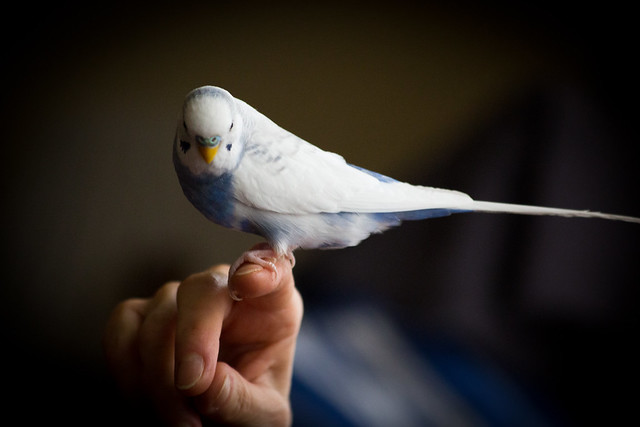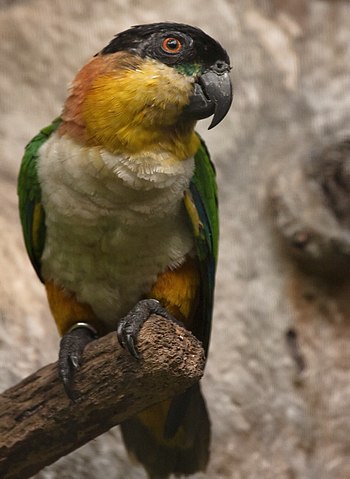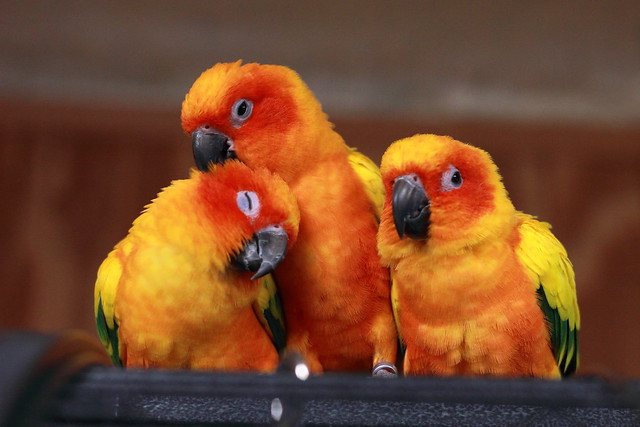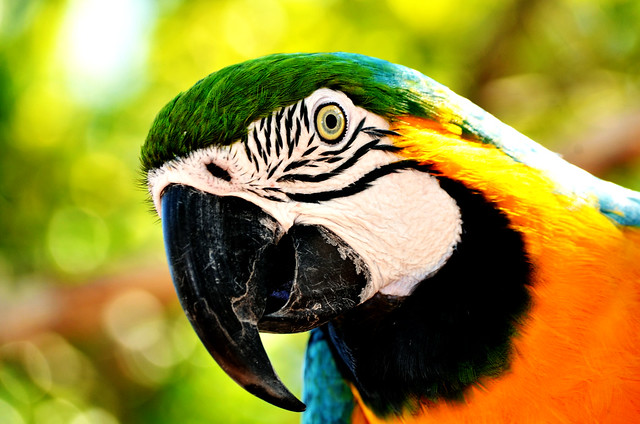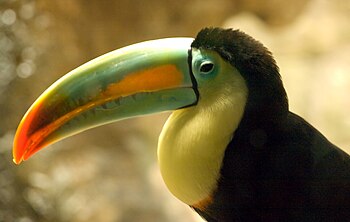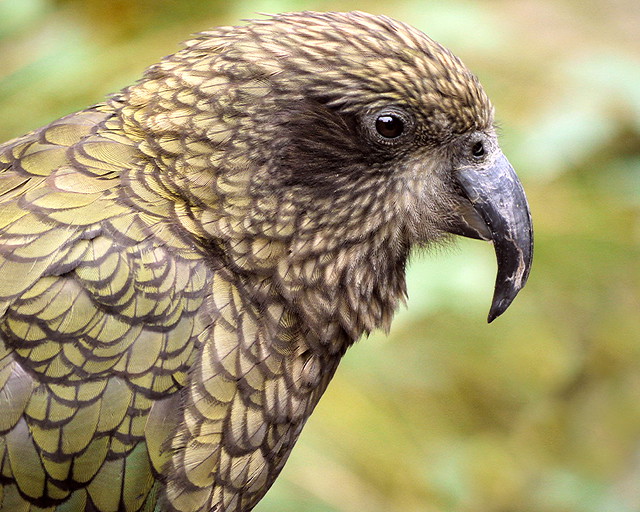 |
| Piasa Bird on cliffs NW of Alton, IL. (Photo credit: Wikipedia) |
If there's nearly one thing universal in Native American mythology it is giant birds, monster birds, even the Thunderbird (which has been adopted as a brand name for many products not to mention the name of a TV show with associated spin-off motion pictures). Now apart from the actual observations of these winged monstrosities, there's nothing all that unusual about giant flying creatures in mythology. What sets these 'birds' apart is that they often like to snack on the natives - as takeaways, not dine in. Is there any natural terrestrial explanation for birds carrying away humans, like a crow picking up a kernel of corn? Or, might one have to resort to another, more unnatural, and perhaps extraterrestrial explanation?
Mythological Monster 'Birds' of the Americas
Dragons: While primarily connected with the Old World (Europe, the Far East, etc.), dragons have some, albeit lesser-known connection in the New World of the Americas, perhaps a bit more in the guise of serpents, that is taking on a serpentine appearance. This is most notably so with respect to that famous feathered serpent (sounds more like a bird actually) Quetzalcoatl, a central Aztec deity, but noted as well in Mayan culture and that other, and mysterious initial Mesoamerican civilization, the Olmecs.
However, we do have the Piasa Bird which is depicted as a dragon in a Native American Indian mural above the Mississippi River near modern Alton, Illinois. It's thought that the originals were done by the Cahokia Indians way before any white settlers arrived in their territory. Their pictographs of animals, birds such as the falcon, bird-men, and serpents (monstrous snakes) were common, as was the Thunderbird icon. According to a local professor living in the area in the 1830s, John Russell, the Piasa Bird depicted in the mural was a monstrous bird that inhabited the area and attacked and ate the locals that inhabited various Indian villages in the area. Apparently, it got a taste for human flesh after scavenging human carrion (corpses).
Thunderbirds & Related: These beasties are nearly universal in Native American Indian mythology, and what's more they carry many similar features. They tend to be very large birds that are seen as the personification of thunder (the beating of their wings) and lightning and all things stormy; a sort of Zeus or Thor but with wings, talons, a beak, and feathers. The Native Americans believed that the giant Thunderbird could shoot lightning from its eyes. Say what? Even odder is that the Thunderbird often has teeth in its beak. We've all heard the phrase "rare as hen's teeth" - well that's because modern birds are toothless.
Thunderbirds were also associated with the Great Spirits so common in Indian lore. They were servants of these deities and apparently acted as messenger-boys (sorry, messenger-birds) - a sort of extra-large carrier pigeon - carrying communications between these various Great Spirits. Thunderbirds were associated with the weather as we've seen, and also with water. Now an interesting parallel is that dragons in the Old World are often viewed as go-betweens between the gods and humanity (sort of again like carrier pigeons) and they're having some control over the weather and the waters were a common feature as well.
So, this mythological monster bird is common throughout Indian legends. Actually, in one case there was a Thunderbird that resembled a giant eagle that was large enough, and powerful enough to carry a whale in its claws. Say what again? According to the Makah people of the Northwest Coast, a Thunderbird saved a village from famine by snatching up a whale from the Pacific Ocean and giving it to the community to feed off of, giving the village food lasting for many weeks. Would this be an American example of a case of manna from Heaven? Now no bird could actually carry even a small whale in its beak or talons, so there must be another explanation.
I've previously related how the Navajos have associated Ship Rock (or Shiprock) in New Mexico with a legend that says they were flown by a 'flying rock' (Ship Rock) provided by their Great Spirit to escape their enemies from up north. The Navajos, in other legends, have associated Ship Rock with the presence of 'Bird Monsters' or cliff monsters that preyed and feed on human Navajo and Zunis flesh. I wonder if that could be a garbled tale of UFO abduction.
Related are the tales of the Yaqui from around the Sonora region in NW Mexico. Yaqui legends tell of enormous birds around Skeleton Mountain that carried off men, women, and children.
There's a petroglyph at Puerco Pueblo (or village) located in the Petrified Forest National Park of an enormous bird with a human suspended in the air by its beak. If we assume the human is of average height, say 5' 6" tall, then the bird, to scale, is roughly 13' 9" tall. That's one very big bird! The petroglyph was carved into stone many, many hundreds upon hundreds of years ago by the ancestors of the Hopis, maybe even by the lost Anasazis.
When it comes to the Thunderbirds, scholars of mythology strongly suggest that this creature is just the embellishment of the California condor, eagles, or the extinct teratorns. However, to my way of thinking, one doesn't usually associate birds with thunder and lightning (i.e. - storms). Now you may see birds riding the thermals that might precede a storm, but you don't tend to see birds out and about in stormy weather - they seek shelter from the elements too. Yet many tribes like the Lakota Sioux or the Ojibwa of the Great Lakes Region make the connection between these Thunderbirds and lightning in particular. Perhaps the association with something flying and thunder and lightning suggest something a bit more technological!
I mean something that can serve as a monster carrier pigeon between the gods, lift huge weights, abduct humans (recorded in many Indian legends), and shoot out lightning bolts doesn't sound like biology to me, rather more something artificial. Now perhaps all these legends of abducting and man-eating giant birds are nothing more than a rogue eagle or condor with too much testosterone in its system who, feeling threatened, attacked a lone Indian and like the fish that got away, the bird just grew and got embellished, and grew some more and got even more embellished until it reached ridiculous proportions and abilities. Well maybe.
Real Monster 'Birds' of the Americas
Pterosaurs and Pterodactyls: These beasties weren't really birds-of-a-feather, rather just winged and flying (or gliding) reptiles that belonged way back, in fact, to 'The Age of Reptiles' - the Mesozoic Era. The largest of these discovered (to date) was Quetzalcoatlus, named obviously after that Mesoamerican feathered serpent deity. Quetzal-baby had a 36 to 40-foot wingspan, and just might have been able to snack on a human. However, pterosaurs and pterodactyls all went kaput by the end of the Mesozoic - Q-baby made it in fact through to the end of the Cretaceous period, 65 millions of years ago. Alas, that was at least 64 million years before anything resembling humans walked the planet as a food source. While Native Americans were probably aware of the fossils of these flying reptiles, they had nothing to fear from them in terms of being snack-food.
Terror Birds: Well, these terrors really existed in the Americas and for a while were thought to be contemporary with the earliest humans in the Americas. Though they survived and thrived in mainly South America, some made it across the Isthmus of Panama land bridge into Central and North America about 3 million years ago. The most recent of them is now thought to have gone extinct about 1.8 million years ago, well before humans arrived on the scene.
But even assuming humans and terror birds were contemporary, why the terror? Well, these crows-on-steroids were up to ten feet tall and could gallop after you at velocities up to some 37 miles per hour. Relatives of these monsters with equally large beaks and talons have been found in Texas and Florida, and presumable bridged the geographical gap in-between. So, should the natives have been afraid; very afraid? Well, in this case, the top apex predators probably succumbed to being ultimately human prey since the terror birds, along with the rest of the North, Central and South American megafauna went extinct in pretty quick-smart fashion after humans appeared on the scene. Now humans, if contemporary, probably didn't engage in hand-to-wing combat with these ungodly raptors, but rather found their eggs as a handy-dandy breakfast food supplement to their gatherer nuts-and-berries fare. Alas, no baby terror birds hatchlings; ultimately no terror birds. In any event, terror birds were flightless, like the emus, cassowaries, the ostrich, and kiwis, not to mention their extinct cousins the moa and dodos. Thus, terror birds don't fit our description of birds that fly and pluck humans off the ground and feel us to their young.
Giant Condors & Related: The Andean condor at 11 to 15 kg (24 - 33 pounds) is currently the Guinness Book of Records holder for being America's largest flying feathered member of the avian clan, at least with respect to a roughly 10 to 12-foot wingspan. The California condor at 7 to 14 kg (15 to 31 pounds) comes a very close second with wingspans around ten feet. Then too there was the Pleistocene [Ice Age] teratogens weighing in at 15 kg to 23 kg (33 to 50 pounds), huge raptors resembling eagles with wingspans 12 to 17 feet across.
Overall the wandering albatross is on a par with the Andean condor for the title of 'king of the wingspan' (up to 11 feet for the great albatrosses), but it isn't a common sight in North America - then or now. There are several North Pacific varieties that reach the western coast of North America, but because these are sea birds, feeding on seafood although scavenging carrion when on land (remote islands) for breeding purposes. The odds that Native American Indians would have noted the albatross as a regular part of their environment wouldn't have been common for other than those living right on the Pacific Ocean.
Now the sixty-four cent question is, can anyone or more of the above account for eyewitness accounts of monster birds abducting their comrades in arms? Well, any sane person would eliminate dragons and Thunderbirds - they are mythological and therefore don't exist. One cannot witness non-existence. Pterosaurs and pterodactyls were extinct long before humans were thought up in anyone's philosophy. Terror birds couldn't fly and probably weren't actually contemporary with humans in any event. Condors, while big, aren't big enough. I mean an average human should be large enough to punch a condor's lights right out, and certainly humans are too large to be carried across the condor's threshold.
Condors (Andean or Californian) are actually vultures and thus scavengers, feeding primarily on carrion, even though preferring large carcasses like those of cattle. It has to feed while on the ground, and often stuffs itself silly when it does come across a suitable meal that it can't, for a while, lift itself off the ground. This is hardly a bird likely to be the source of American Indian human-abducting mythology, although the bird certainly features in Native American mythology. However, as the condor is an endangered species, the bird had and has way more reason to fear the natives than the other way around.
The extinct teratorns however were contemporary with humans (Amerindians), but while large enough to cause more than sufficient trouble for a human infant, there's evidence to suggest that overall, the humans were probably more the hunters than the hunted when the crunch came the crunch.
However, even at a weight of fifty pounds and a wingspan of 17 feet, could a teratorn have actually picked up and carried away an adult human, with a weight say at least twice or thrice that of the raptor? Fossil evidence suggests that small mammals, even fish, and carrion were its usual means of sustenance. Since the Native Americans say it's so - at least according to their mythology - you have to ask yourself whether or not a 50-pound bird, who could obviously carry its own weight and probably a bit more through the air, could actually fly with a 100 to 150-pound payload? That's 150 to 200 pounds all up the bird is carrying. Now that's a pretty big ask.
Has anyone seen an owl or an eagle or other flying raptor carry off prey two to three times its own weight? Now it might be one thing for a very large bird to pick you up (especially if you're dead and not struggling) and carry you off while in contact with the ground, like the terror birds, at least for a short way since after all you're still very heavy compared to the bird. But it's quite another kettle of fish for a bird to pick you up and actually fly away with you without any leg and ground support at all. Flying (flapping wings) is very energy-intensive at the best of times (we've all seen birds in gliding mode in order to conserve energy), far less trying to lift up and flap wings with twice or thrice its normal body weight to struggle with.
Now we've all seen wildlife documentaries showing a large carnivorous bird swooping low over the water and then grabbing an unsuspecting fish out of the water with its talons. Now that fish may even be as large and heavy as the bird itself, but the prey can't be that much larger and certainly not twice as large and heavy as the predator. The bird, so close to the water, can not afford to be dragged down by extra unmanageable weight into the water - then it's bye-bye birdie.
Moving back to the land, raptor birds can and do attack prey much larger than themselves. The bones of these large prey animals have been found in the raptor's nests or lairs. An eagle might attack a deer or fawn. The deer can't really defend itself very well out in the open. But that's not to say that the eagle can actually carry off the deer carcass whole, rather it's going to tear out chunks at a time and carry them take-away style back to the nest. If not feeding young, it just might dine in on the spot, only flapping away if threatened by the appearance of larger scavengers.
In human terms, a normal average fit human may be able to live twice its body weight but can't hardly be expected to run an obstacle course carrying it. Half a human's body weight maybe, but not twice far less thrice.
Now in more 'modern' times, there have been a few sightings of giant and other unknown birds - critters that fall within the realm of study called cryptozoology. Having looked over the 'modern' (1850 to date) cryptozoological literature, most sightings prove to be ordinary birds though perhaps viewed out of their normal territory and thus somewhat unfamiliar to the viewer. Most unexplained avian species remain unverified and usually too small to be the sort of critter we've been looking for. Sightings of monster birds, while they exist, have never yielded up the sort of data that would have confirmed their reality. No dung, no feathers, no carcass, no bones. Unknown monster birds, if they do still exist, are running out of habitat to hide in; in fact, they probably have run out of viable environmental living space. If they haven't been confirmed by now they probably won't ever be. Besides, any unknown North American birds, monster or otherwise, would have long since been shot out of the sky by trigger-happy Americans.
Conclusions: No flying bird that is or was contemporary with humans (like the American Indian) was capable of lifting up and carrying off anything other than perhaps a small infant; certainly not adults. Flying birds are lightweights - they have to be in order to lift themselves up into the air. The largest of the predatory flightless birds (terror birds) were probably capable of running down, capturing, and lifting up human adults, but that's not what the legends describe. But to a technologically unsophisticated Native American, living hundreds to thousands of years ago, a UFO abduction event might only have made natural sense to them in a Thunderbird related scenario.
Further Readings about Monster Birds:
Allan, Tony; "Beasts of the air" (in); The Mythic Bestiary: The Illustrated Guide to the World's Most Fantastical Creatures; Duncan Baird Publishers, London; 2008; pages 14-53.
Bord, Colin & Bord, Janet; "Giant birds and birdmen" (in); Alien Animals: A Worldwide Investigation; Panther Books, London; Revised Edition 1985; pages 109-135.
Clark, Jerome & Coleman, Loren; "Things with wings" (in); Creatures of the Outer Edge; Warner Books, New York; 1978; pages 165-194.
Mackal, Roy P.; "'Alice in Wonderland' birds" (in); Searching for Hidden Animals: An Inquiry Into Zoological Mysteries; Doubleday & Company, New York; 1980; pages 99-128.
Mayor, Adrienne; Fossil Legends of the First Americans; Princeton University Press, Princeton, New Jersey; 2005.Science librarian; retired.
|


